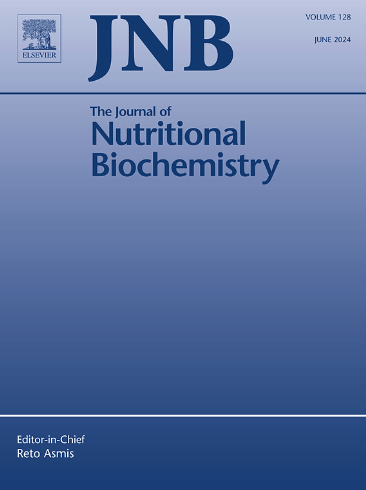维持性血液透析患者膳食纤维摄入量与全因死亡率和心血管死亡率的关系:一项回顾性队列研究
IF 4.8
2区 医学
Q1 BIOCHEMISTRY & MOLECULAR BIOLOGY
引用次数: 0
摘要
目的:探讨膳食纤维摄入量(DFI)与中国维持性血液透析(MHD)患者全因死亡率和心血管死亡率之间的关系,考虑纤维类型和来源。方法:采用校正Cox回归分析评估DFI四分位数与死亡率之间的相关性。采用限制性三次样条(RCS)回归分析了谷物纤维总量与死亡率之间的非线性关系。进行亚组分析和敏感性分析以检验稳健性。结果:742例患者(中位随访时间30.47个月)中,210例(28.30%)死亡,其中心血管相关死亡149例(20.08%)。较高的谷物纤维总摄入量与全因死亡率降低相关[HR(风险比)四分位数4 (Q4) vs四分位数1 (Q1) = 0.58,95% CI: 0.36-0.93]和心血管死亡率降低相关(HR Q4 vs Q1 = 0.53,95% CI = 0.30-0.95)。除了水果纤维和豆类纤维与全因死亡率有关,可溶性水果纤维与心血管死亡率有关外,其他膳食来源的纤维也存在类似的关联,尽管没有统计学意义。此外,谷物纤维总摄入量每增加一个标准差,全因死亡风险就会降低(HR = 0.82,95% CI: 0.69-0.98)。结果在所有亚组和敏感性分析中都是稳健的。此外,RCS回归模型显示,总谷物纤维与死亡风险呈线性负相关(均为平面非线性bb0 0.05)。结论:谷物纤维总摄入量与MHD患者全因死亡率和心血管死亡率降低呈负相关。我们的数据表明,谷物纤维是一种潜在的保护成分,可能会延长MHD患者的总体寿命。本文章由计算机程序翻译,如有差异,请以英文原文为准。
Associations of dietary fiber intake with all-cause and cardiovascular mortality among maintenance hemodialysis patients: a retrospective cohort study
To determine the association between dietary fiber intake (DFI) and all-cause mortality and cardiovascular mortality in Chinese maintenance hemodialysis (MHD) patients, considering fiber types and sources. Therefore, adjusted Cox regression analyses were utilized to assess the correlation between quartiles of DFI and mortality. Restricted cubic spline (RCS) regression was employed to investigate the nonlinear relationship between the total cereal fiber and mortality. Subgroup and sensitivity analysis was performed to examine the robustness. Among 742 patients (median follow-up: 30.47 months), 210 deaths (28.30%) occurred, including 149 (20.08%) cardiovascular-related deaths. Higher total cereal fiber intake correlated with reduced all-cause mortality [HR (hazard ratio) quartile 4 (Q4) vs. quartile 1 (Q1)=0.58, 95% CI: 0.36–0.93] and cardiovascular mortality (HR Q4 vs. Q1=0.53, 95% CI=0.30–0.95). Apart from fruit fiber as well as bean fiber for all-cause mortality and soluble fruit fiber for cardiovascular mortality, a similar association was observed for fiber from other dietary sources, albeit without statistical significance. Furthermore, each standard deviation increase in total cereal fiber intake lowered all-cause mortality risk (HR=0.82, 95% CI: 0.69–0.98). The findings were robust in all the subgroup and sensitivity analyses. Additionally, the RCS regression model indicated linear inverse associations between total cereal fiber and mortality risks (all p nonlinear>.05). In conclusion, total cereal fiber intake was inversely associated with reduced all-cause and cardiovascular mortality in MHD patients. Our data suggest that cereal fiber is a potentially protective component and may enhance overall longevity in MHD patients.
求助全文
通过发布文献求助,成功后即可免费获取论文全文。
去求助
来源期刊

Journal of Nutritional Biochemistry
医学-生化与分子生物学
CiteScore
9.50
自引率
3.60%
发文量
237
审稿时长
68 days
期刊介绍:
Devoted to advancements in nutritional sciences, The Journal of Nutritional Biochemistry presents experimental nutrition research as it relates to: biochemistry, molecular biology, toxicology, or physiology.
Rigorous reviews by an international editorial board of distinguished scientists ensure publication of the most current and key research being conducted in nutrition at the cellular, animal and human level. In addition to its monthly features of critical reviews and research articles, The Journal of Nutritional Biochemistry also periodically publishes emerging issues, experimental methods, and other types of articles.
 求助内容:
求助内容: 应助结果提醒方式:
应助结果提醒方式:


